Human Resource Management Report: Recruitment, Reward, and Termination
VerifiedAdded on 2020/01/28
|18
|5768
|109
Report
AI Summary
This report provides a comprehensive analysis of Human Resource Management (HRM) practices, focusing on key functions and strategies within the context of Tesco and Virgin Media. The report begins by differentiating between personnel and human resource management, exploring the roles of HRM functions in achieving organizational goals, and examining the responsibilities of line managers. It then delves into recruitment and selection processes, comparing the approaches of Tesco and Virgin Media, and evaluating their effectiveness. The report also examines motivational theories and reward systems, evaluating job evaluation processes and the effectiveness of rewards in different contexts. Finally, it explores employee termination procedures, considering the impact of legal and regulatory frameworks on employment cessation. The report provides insights into HR planning, legal compliance, and best practices in HRM.
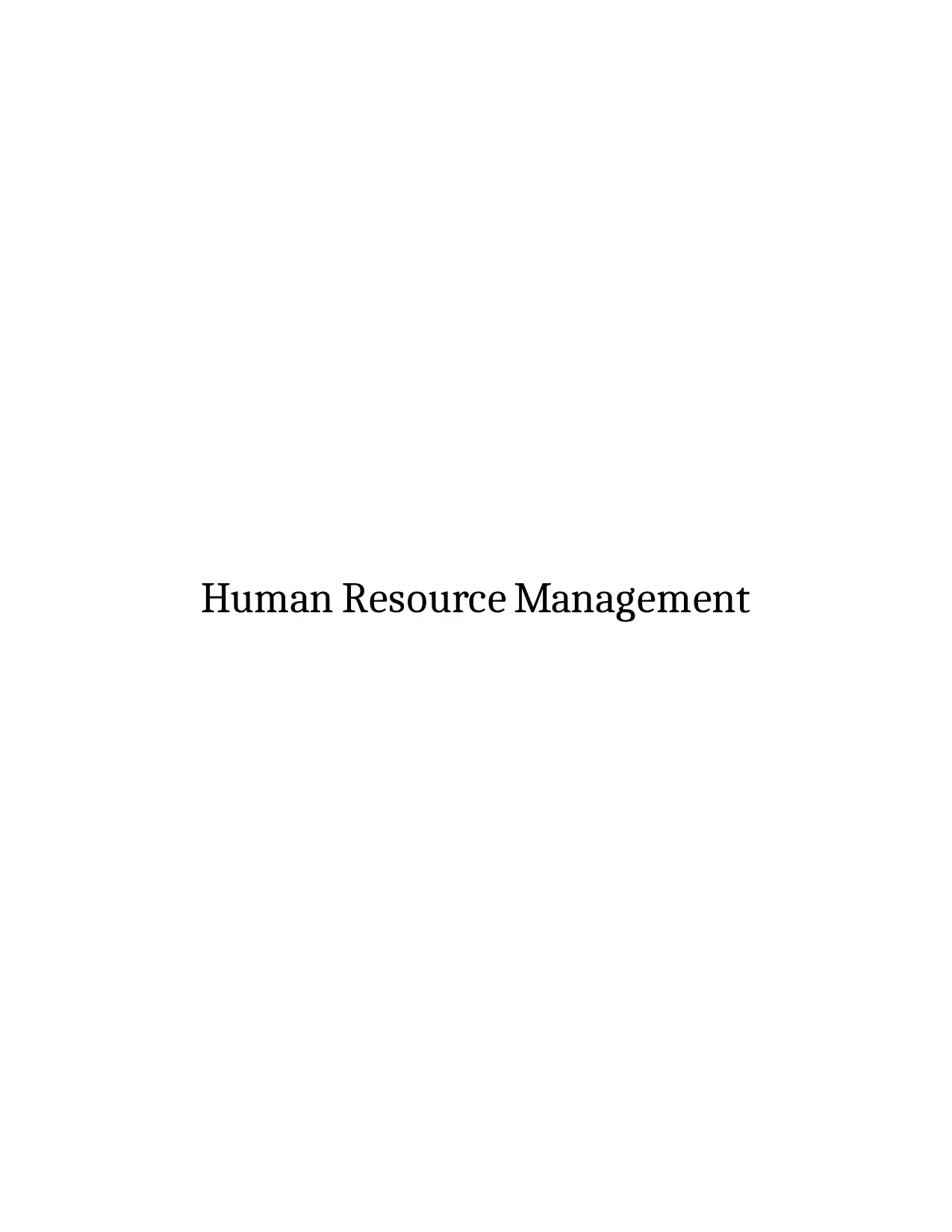
Human Resource Management
Paraphrase This Document
Need a fresh take? Get an instant paraphrase of this document with our AI Paraphraser
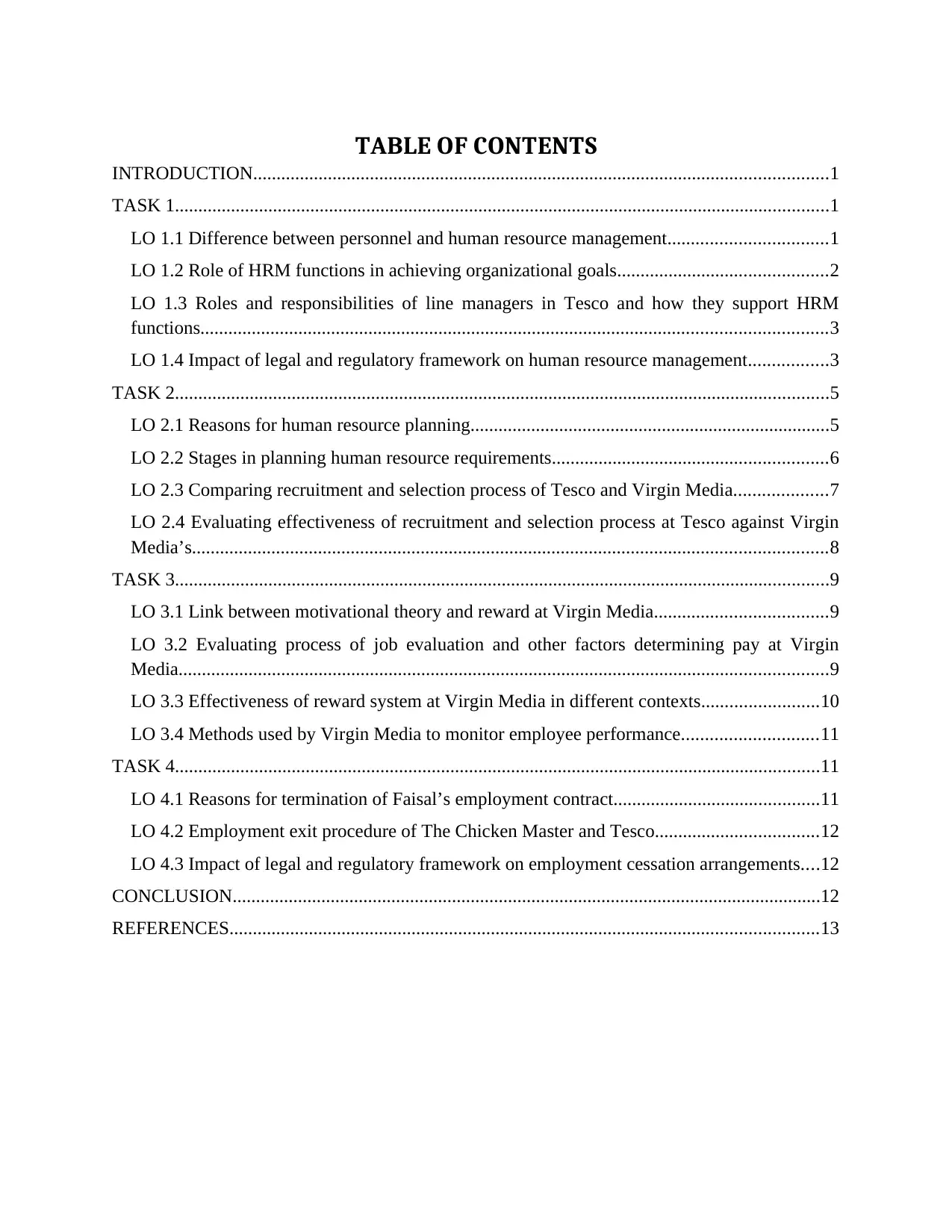
TABLE OF CONTENTS
INTRODUCTION...........................................................................................................................1
TASK 1............................................................................................................................................1
LO 1.1 Difference between personnel and human resource management..................................1
LO 1.2 Role of HRM functions in achieving organizational goals.............................................2
LO 1.3 Roles and responsibilities of line managers in Tesco and how they support HRM
functions......................................................................................................................................3
LO 1.4 Impact of legal and regulatory framework on human resource management.................3
TASK 2............................................................................................................................................5
LO 2.1 Reasons for human resource planning.............................................................................5
LO 2.2 Stages in planning human resource requirements...........................................................6
LO 2.3 Comparing recruitment and selection process of Tesco and Virgin Media....................7
LO 2.4 Evaluating effectiveness of recruitment and selection process at Tesco against Virgin
Media’s........................................................................................................................................8
TASK 3............................................................................................................................................9
LO 3.1 Link between motivational theory and reward at Virgin Media.....................................9
LO 3.2 Evaluating process of job evaluation and other factors determining pay at Virgin
Media...........................................................................................................................................9
LO 3.3 Effectiveness of reward system at Virgin Media in different contexts.........................10
LO 3.4 Methods used by Virgin Media to monitor employee performance.............................11
TASK 4..........................................................................................................................................11
LO 4.1 Reasons for termination of Faisal’s employment contract............................................11
LO 4.2 Employment exit procedure of The Chicken Master and Tesco...................................12
LO 4.3 Impact of legal and regulatory framework on employment cessation arrangements....12
CONCLUSION..............................................................................................................................12
REFERENCES..............................................................................................................................13
INTRODUCTION...........................................................................................................................1
TASK 1............................................................................................................................................1
LO 1.1 Difference between personnel and human resource management..................................1
LO 1.2 Role of HRM functions in achieving organizational goals.............................................2
LO 1.3 Roles and responsibilities of line managers in Tesco and how they support HRM
functions......................................................................................................................................3
LO 1.4 Impact of legal and regulatory framework on human resource management.................3
TASK 2............................................................................................................................................5
LO 2.1 Reasons for human resource planning.............................................................................5
LO 2.2 Stages in planning human resource requirements...........................................................6
LO 2.3 Comparing recruitment and selection process of Tesco and Virgin Media....................7
LO 2.4 Evaluating effectiveness of recruitment and selection process at Tesco against Virgin
Media’s........................................................................................................................................8
TASK 3............................................................................................................................................9
LO 3.1 Link between motivational theory and reward at Virgin Media.....................................9
LO 3.2 Evaluating process of job evaluation and other factors determining pay at Virgin
Media...........................................................................................................................................9
LO 3.3 Effectiveness of reward system at Virgin Media in different contexts.........................10
LO 3.4 Methods used by Virgin Media to monitor employee performance.............................11
TASK 4..........................................................................................................................................11
LO 4.1 Reasons for termination of Faisal’s employment contract............................................11
LO 4.2 Employment exit procedure of The Chicken Master and Tesco...................................12
LO 4.3 Impact of legal and regulatory framework on employment cessation arrangements....12
CONCLUSION..............................................................................................................................12
REFERENCES..............................................................................................................................13
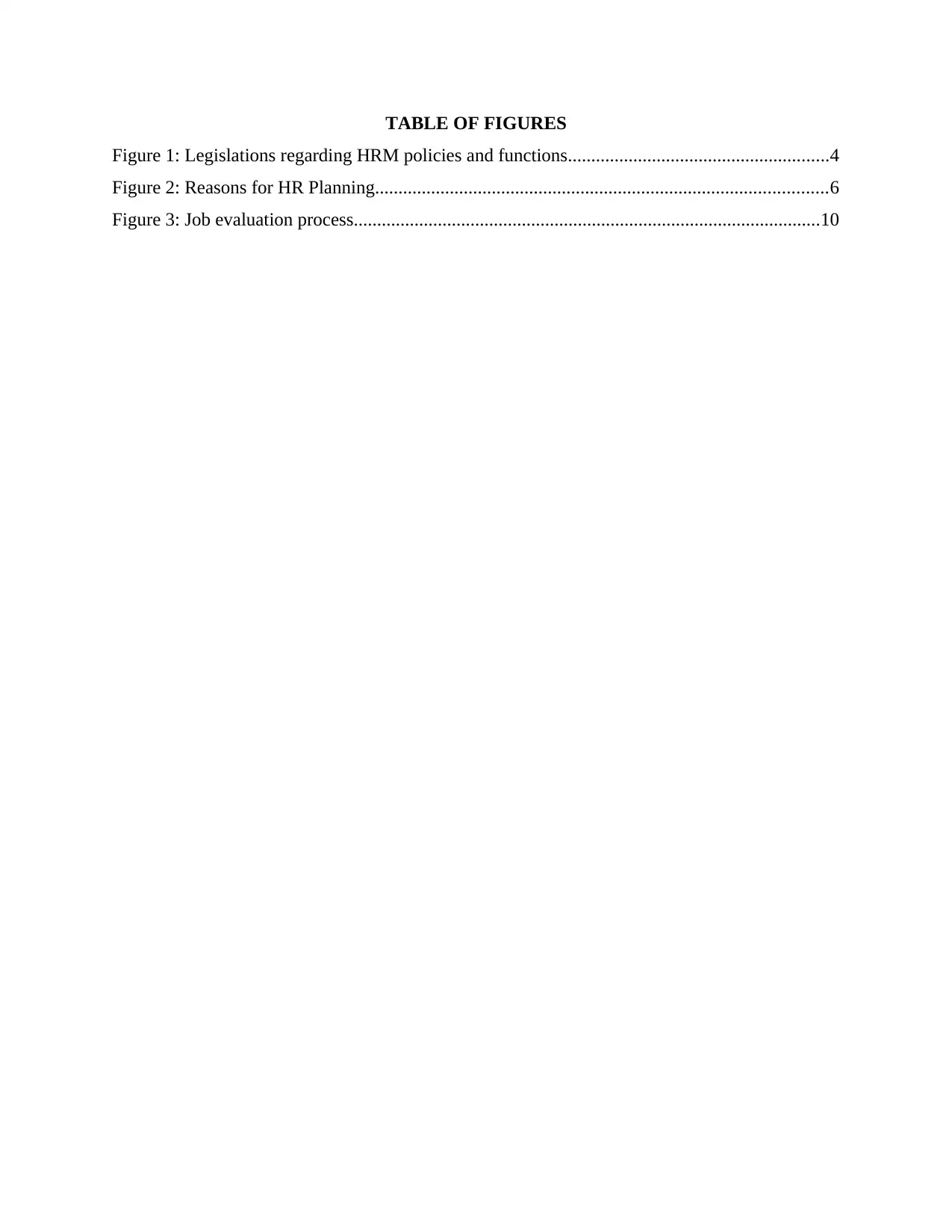
TABLE OF FIGURES
Figure 1: Legislations regarding HRM policies and functions........................................................4
Figure 2: Reasons for HR Planning.................................................................................................6
Figure 3: Job evaluation process....................................................................................................10
Figure 1: Legislations regarding HRM policies and functions........................................................4
Figure 2: Reasons for HR Planning.................................................................................................6
Figure 3: Job evaluation process....................................................................................................10
⊘ This is a preview!⊘
Do you want full access?
Subscribe today to unlock all pages.

Trusted by 1+ million students worldwide
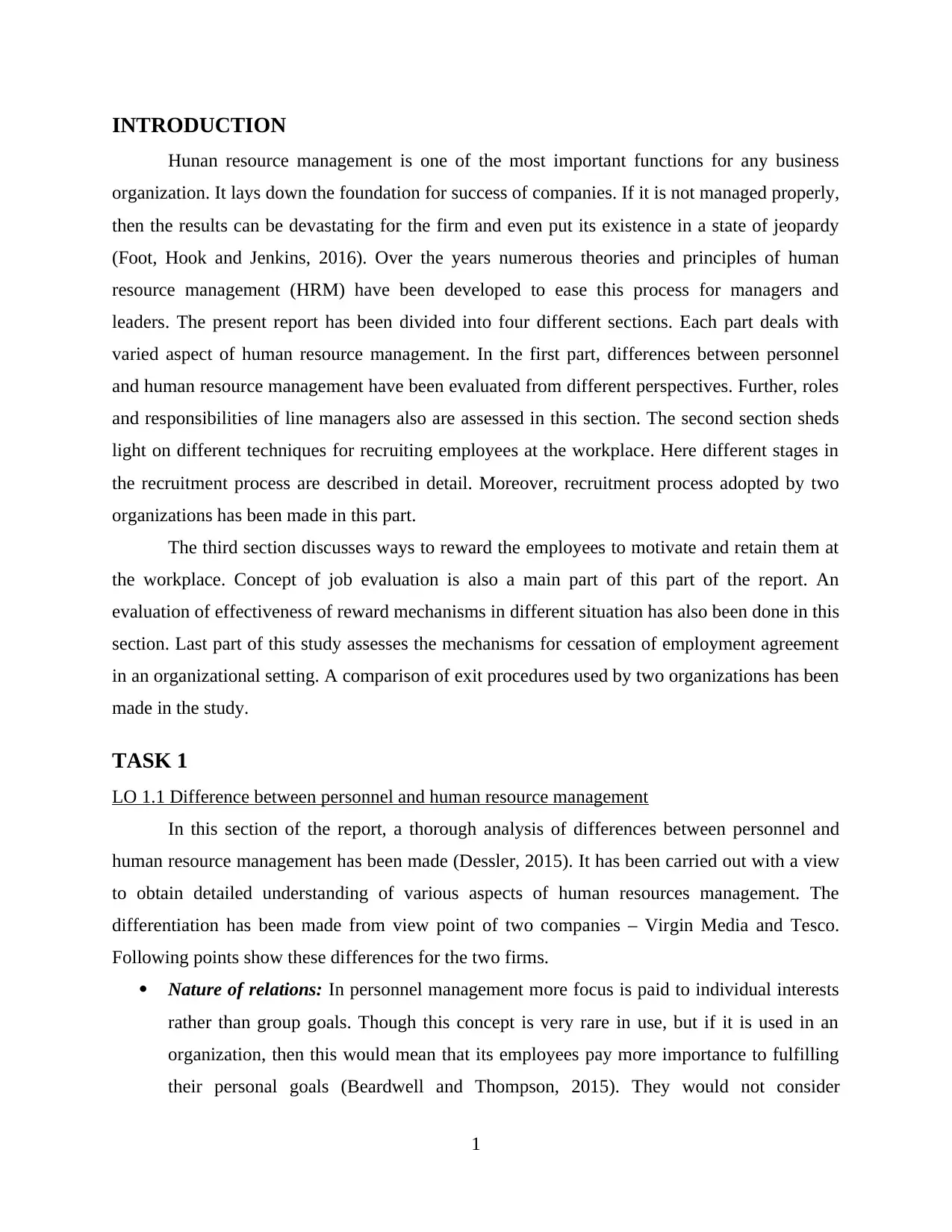
INTRODUCTION
Hunan resource management is one of the most important functions for any business
organization. It lays down the foundation for success of companies. If it is not managed properly,
then the results can be devastating for the firm and even put its existence in a state of jeopardy
(Foot, Hook and Jenkins, 2016). Over the years numerous theories and principles of human
resource management (HRM) have been developed to ease this process for managers and
leaders. The present report has been divided into four different sections. Each part deals with
varied aspect of human resource management. In the first part, differences between personnel
and human resource management have been evaluated from different perspectives. Further, roles
and responsibilities of line managers also are assessed in this section. The second section sheds
light on different techniques for recruiting employees at the workplace. Here different stages in
the recruitment process are described in detail. Moreover, recruitment process adopted by two
organizations has been made in this part.
The third section discusses ways to reward the employees to motivate and retain them at
the workplace. Concept of job evaluation is also a main part of this part of the report. An
evaluation of effectiveness of reward mechanisms in different situation has also been done in this
section. Last part of this study assesses the mechanisms for cessation of employment agreement
in an organizational setting. A comparison of exit procedures used by two organizations has been
made in the study.
TASK 1
LO 1.1 Difference between personnel and human resource management
In this section of the report, a thorough analysis of differences between personnel and
human resource management has been made (Dessler, 2015). It has been carried out with a view
to obtain detailed understanding of various aspects of human resources management. The
differentiation has been made from view point of two companies – Virgin Media and Tesco.
Following points show these differences for the two firms.
Nature of relations: In personnel management more focus is paid to individual interests
rather than group goals. Though this concept is very rare in use, but if it is used in an
organization, then this would mean that its employees pay more importance to fulfilling
their personal goals (Beardwell and Thompson, 2015). They would not consider
1
Hunan resource management is one of the most important functions for any business
organization. It lays down the foundation for success of companies. If it is not managed properly,
then the results can be devastating for the firm and even put its existence in a state of jeopardy
(Foot, Hook and Jenkins, 2016). Over the years numerous theories and principles of human
resource management (HRM) have been developed to ease this process for managers and
leaders. The present report has been divided into four different sections. Each part deals with
varied aspect of human resource management. In the first part, differences between personnel
and human resource management have been evaluated from different perspectives. Further, roles
and responsibilities of line managers also are assessed in this section. The second section sheds
light on different techniques for recruiting employees at the workplace. Here different stages in
the recruitment process are described in detail. Moreover, recruitment process adopted by two
organizations has been made in this part.
The third section discusses ways to reward the employees to motivate and retain them at
the workplace. Concept of job evaluation is also a main part of this part of the report. An
evaluation of effectiveness of reward mechanisms in different situation has also been done in this
section. Last part of this study assesses the mechanisms for cessation of employment agreement
in an organizational setting. A comparison of exit procedures used by two organizations has been
made in the study.
TASK 1
LO 1.1 Difference between personnel and human resource management
In this section of the report, a thorough analysis of differences between personnel and
human resource management has been made (Dessler, 2015). It has been carried out with a view
to obtain detailed understanding of various aspects of human resources management. The
differentiation has been made from view point of two companies – Virgin Media and Tesco.
Following points show these differences for the two firms.
Nature of relations: In personnel management more focus is paid to individual interests
rather than group goals. Though this concept is very rare in use, but if it is used in an
organization, then this would mean that its employees pay more importance to fulfilling
their personal goals (Beardwell and Thompson, 2015). They would not consider
1
Paraphrase This Document
Need a fresh take? Get an instant paraphrase of this document with our AI Paraphraser
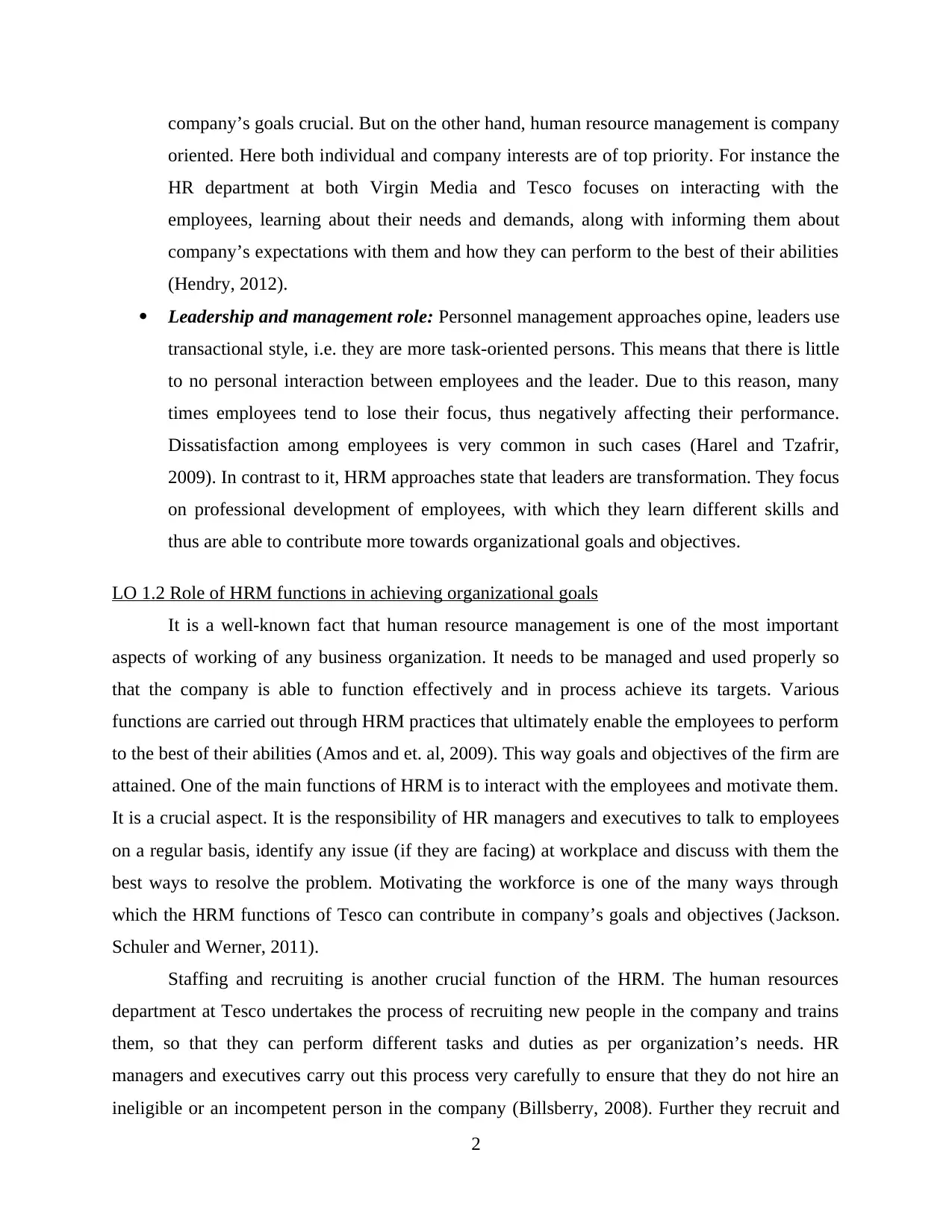
company’s goals crucial. But on the other hand, human resource management is company
oriented. Here both individual and company interests are of top priority. For instance the
HR department at both Virgin Media and Tesco focuses on interacting with the
employees, learning about their needs and demands, along with informing them about
company’s expectations with them and how they can perform to the best of their abilities
(Hendry, 2012).
Leadership and management role: Personnel management approaches opine, leaders use
transactional style, i.e. they are more task-oriented persons. This means that there is little
to no personal interaction between employees and the leader. Due to this reason, many
times employees tend to lose their focus, thus negatively affecting their performance.
Dissatisfaction among employees is very common in such cases (Harel and Tzafrir,
2009). In contrast to it, HRM approaches state that leaders are transformation. They focus
on professional development of employees, with which they learn different skills and
thus are able to contribute more towards organizational goals and objectives.
LO 1.2 Role of HRM functions in achieving organizational goals
It is a well-known fact that human resource management is one of the most important
aspects of working of any business organization. It needs to be managed and used properly so
that the company is able to function effectively and in process achieve its targets. Various
functions are carried out through HRM practices that ultimately enable the employees to perform
to the best of their abilities (Amos and et. al, 2009). This way goals and objectives of the firm are
attained. One of the main functions of HRM is to interact with the employees and motivate them.
It is a crucial aspect. It is the responsibility of HR managers and executives to talk to employees
on a regular basis, identify any issue (if they are facing) at workplace and discuss with them the
best ways to resolve the problem. Motivating the workforce is one of the many ways through
which the HRM functions of Tesco can contribute in company’s goals and objectives (Jackson.
Schuler and Werner, 2011).
Staffing and recruiting is another crucial function of the HRM. The human resources
department at Tesco undertakes the process of recruiting new people in the company and trains
them, so that they can perform different tasks and duties as per organization’s needs. HR
managers and executives carry out this process very carefully to ensure that they do not hire an
ineligible or an incompetent person in the company (Billsberry, 2008). Further they recruit and
2
oriented. Here both individual and company interests are of top priority. For instance the
HR department at both Virgin Media and Tesco focuses on interacting with the
employees, learning about their needs and demands, along with informing them about
company’s expectations with them and how they can perform to the best of their abilities
(Hendry, 2012).
Leadership and management role: Personnel management approaches opine, leaders use
transactional style, i.e. they are more task-oriented persons. This means that there is little
to no personal interaction between employees and the leader. Due to this reason, many
times employees tend to lose their focus, thus negatively affecting their performance.
Dissatisfaction among employees is very common in such cases (Harel and Tzafrir,
2009). In contrast to it, HRM approaches state that leaders are transformation. They focus
on professional development of employees, with which they learn different skills and
thus are able to contribute more towards organizational goals and objectives.
LO 1.2 Role of HRM functions in achieving organizational goals
It is a well-known fact that human resource management is one of the most important
aspects of working of any business organization. It needs to be managed and used properly so
that the company is able to function effectively and in process achieve its targets. Various
functions are carried out through HRM practices that ultimately enable the employees to perform
to the best of their abilities (Amos and et. al, 2009). This way goals and objectives of the firm are
attained. One of the main functions of HRM is to interact with the employees and motivate them.
It is a crucial aspect. It is the responsibility of HR managers and executives to talk to employees
on a regular basis, identify any issue (if they are facing) at workplace and discuss with them the
best ways to resolve the problem. Motivating the workforce is one of the many ways through
which the HRM functions of Tesco can contribute in company’s goals and objectives (Jackson.
Schuler and Werner, 2011).
Staffing and recruiting is another crucial function of the HRM. The human resources
department at Tesco undertakes the process of recruiting new people in the company and trains
them, so that they can perform different tasks and duties as per organization’s needs. HR
managers and executives carry out this process very carefully to ensure that they do not hire an
ineligible or an incompetent person in the company (Billsberry, 2008). Further they recruit and
2
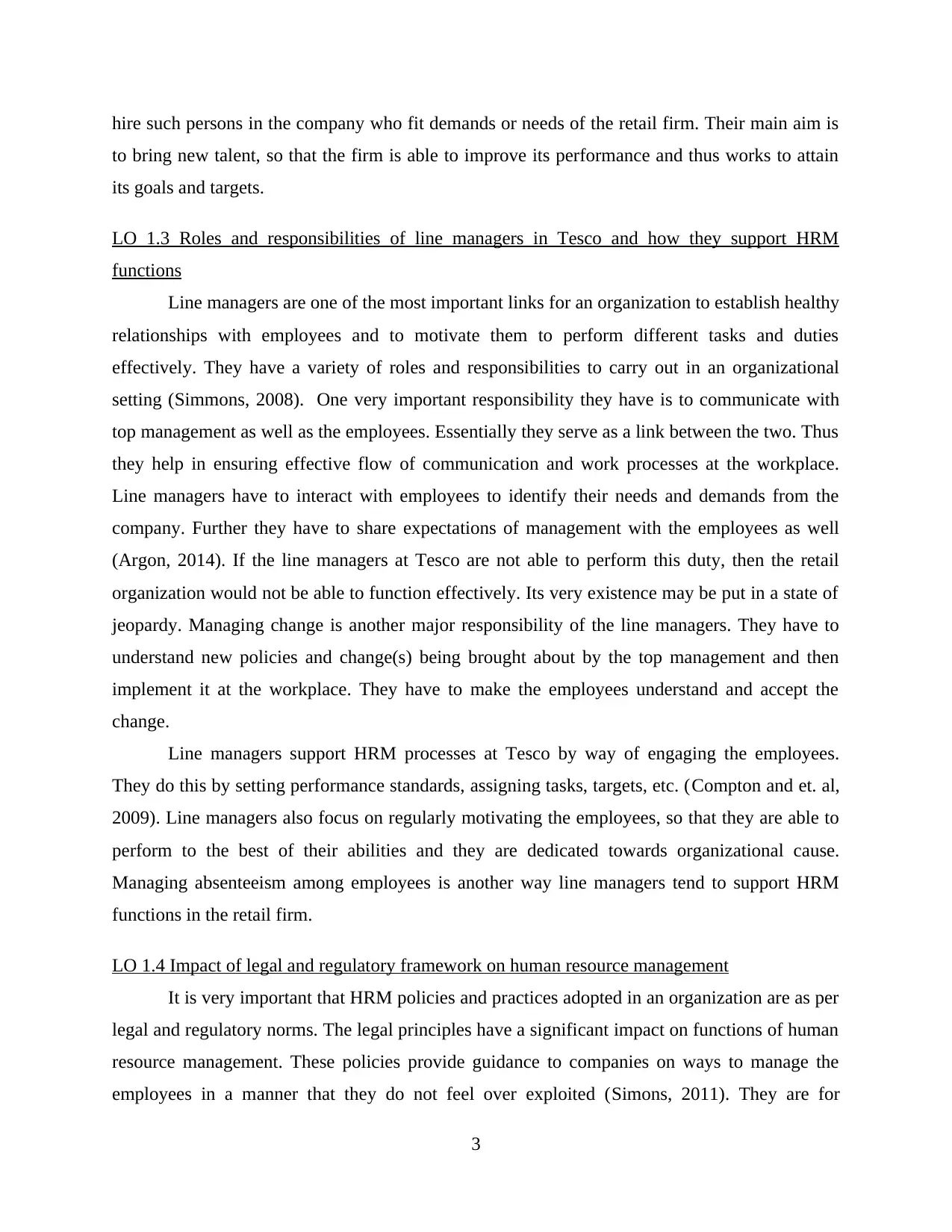
hire such persons in the company who fit demands or needs of the retail firm. Their main aim is
to bring new talent, so that the firm is able to improve its performance and thus works to attain
its goals and targets.
LO 1.3 Roles and responsibilities of line managers in Tesco and how they support HRM
functions
Line managers are one of the most important links for an organization to establish healthy
relationships with employees and to motivate them to perform different tasks and duties
effectively. They have a variety of roles and responsibilities to carry out in an organizational
setting (Simmons, 2008). One very important responsibility they have is to communicate with
top management as well as the employees. Essentially they serve as a link between the two. Thus
they help in ensuring effective flow of communication and work processes at the workplace.
Line managers have to interact with employees to identify their needs and demands from the
company. Further they have to share expectations of management with the employees as well
(Argon, 2014). If the line managers at Tesco are not able to perform this duty, then the retail
organization would not be able to function effectively. Its very existence may be put in a state of
jeopardy. Managing change is another major responsibility of the line managers. They have to
understand new policies and change(s) being brought about by the top management and then
implement it at the workplace. They have to make the employees understand and accept the
change.
Line managers support HRM processes at Tesco by way of engaging the employees.
They do this by setting performance standards, assigning tasks, targets, etc. (Compton and et. al,
2009). Line managers also focus on regularly motivating the employees, so that they are able to
perform to the best of their abilities and they are dedicated towards organizational cause.
Managing absenteeism among employees is another way line managers tend to support HRM
functions in the retail firm.
LO 1.4 Impact of legal and regulatory framework on human resource management
It is very important that HRM policies and practices adopted in an organization are as per
legal and regulatory norms. The legal principles have a significant impact on functions of human
resource management. These policies provide guidance to companies on ways to manage the
employees in a manner that they do not feel over exploited (Simons, 2011). They are for
3
to bring new talent, so that the firm is able to improve its performance and thus works to attain
its goals and targets.
LO 1.3 Roles and responsibilities of line managers in Tesco and how they support HRM
functions
Line managers are one of the most important links for an organization to establish healthy
relationships with employees and to motivate them to perform different tasks and duties
effectively. They have a variety of roles and responsibilities to carry out in an organizational
setting (Simmons, 2008). One very important responsibility they have is to communicate with
top management as well as the employees. Essentially they serve as a link between the two. Thus
they help in ensuring effective flow of communication and work processes at the workplace.
Line managers have to interact with employees to identify their needs and demands from the
company. Further they have to share expectations of management with the employees as well
(Argon, 2014). If the line managers at Tesco are not able to perform this duty, then the retail
organization would not be able to function effectively. Its very existence may be put in a state of
jeopardy. Managing change is another major responsibility of the line managers. They have to
understand new policies and change(s) being brought about by the top management and then
implement it at the workplace. They have to make the employees understand and accept the
change.
Line managers support HRM processes at Tesco by way of engaging the employees.
They do this by setting performance standards, assigning tasks, targets, etc. (Compton and et. al,
2009). Line managers also focus on regularly motivating the employees, so that they are able to
perform to the best of their abilities and they are dedicated towards organizational cause.
Managing absenteeism among employees is another way line managers tend to support HRM
functions in the retail firm.
LO 1.4 Impact of legal and regulatory framework on human resource management
It is very important that HRM policies and practices adopted in an organization are as per
legal and regulatory norms. The legal principles have a significant impact on functions of human
resource management. These policies provide guidance to companies on ways to manage the
employees in a manner that they do not feel over exploited (Simons, 2011). They are for
3
⊘ This is a preview!⊘
Do you want full access?
Subscribe today to unlock all pages.

Trusted by 1+ million students worldwide
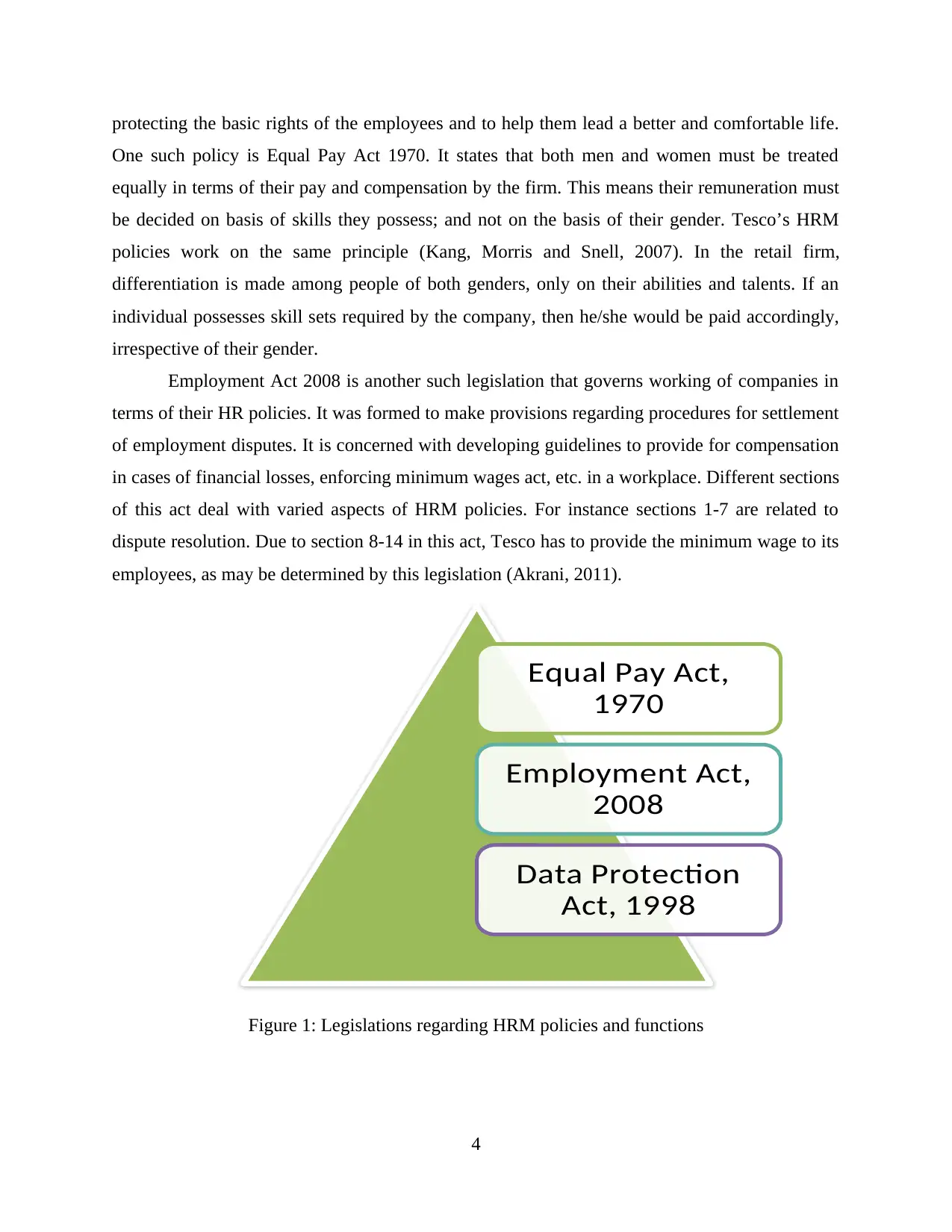
protecting the basic rights of the employees and to help them lead a better and comfortable life.
One such policy is Equal Pay Act 1970. It states that both men and women must be treated
equally in terms of their pay and compensation by the firm. This means their remuneration must
be decided on basis of skills they possess; and not on the basis of their gender. Tesco’s HRM
policies work on the same principle (Kang, Morris and Snell, 2007). In the retail firm,
differentiation is made among people of both genders, only on their abilities and talents. If an
individual possesses skill sets required by the company, then he/she would be paid accordingly,
irrespective of their gender.
Employment Act 2008 is another such legislation that governs working of companies in
terms of their HR policies. It was formed to make provisions regarding procedures for settlement
of employment disputes. It is concerned with developing guidelines to provide for compensation
in cases of financial losses, enforcing minimum wages act, etc. in a workplace. Different sections
of this act deal with varied aspects of HRM policies. For instance sections 1-7 are related to
dispute resolution. Due to section 8-14 in this act, Tesco has to provide the minimum wage to its
employees, as may be determined by this legislation (Akrani, 2011).
Figure 1: Legislations regarding HRM policies and functions
4
Equal Pay Act,
1970
Employment Act,
2008
Data Protection
Act, 1998
One such policy is Equal Pay Act 1970. It states that both men and women must be treated
equally in terms of their pay and compensation by the firm. This means their remuneration must
be decided on basis of skills they possess; and not on the basis of their gender. Tesco’s HRM
policies work on the same principle (Kang, Morris and Snell, 2007). In the retail firm,
differentiation is made among people of both genders, only on their abilities and talents. If an
individual possesses skill sets required by the company, then he/she would be paid accordingly,
irrespective of their gender.
Employment Act 2008 is another such legislation that governs working of companies in
terms of their HR policies. It was formed to make provisions regarding procedures for settlement
of employment disputes. It is concerned with developing guidelines to provide for compensation
in cases of financial losses, enforcing minimum wages act, etc. in a workplace. Different sections
of this act deal with varied aspects of HRM policies. For instance sections 1-7 are related to
dispute resolution. Due to section 8-14 in this act, Tesco has to provide the minimum wage to its
employees, as may be determined by this legislation (Akrani, 2011).
Figure 1: Legislations regarding HRM policies and functions
4
Equal Pay Act,
1970
Employment Act,
2008
Data Protection
Act, 1998
Paraphrase This Document
Need a fresh take? Get an instant paraphrase of this document with our AI Paraphraser
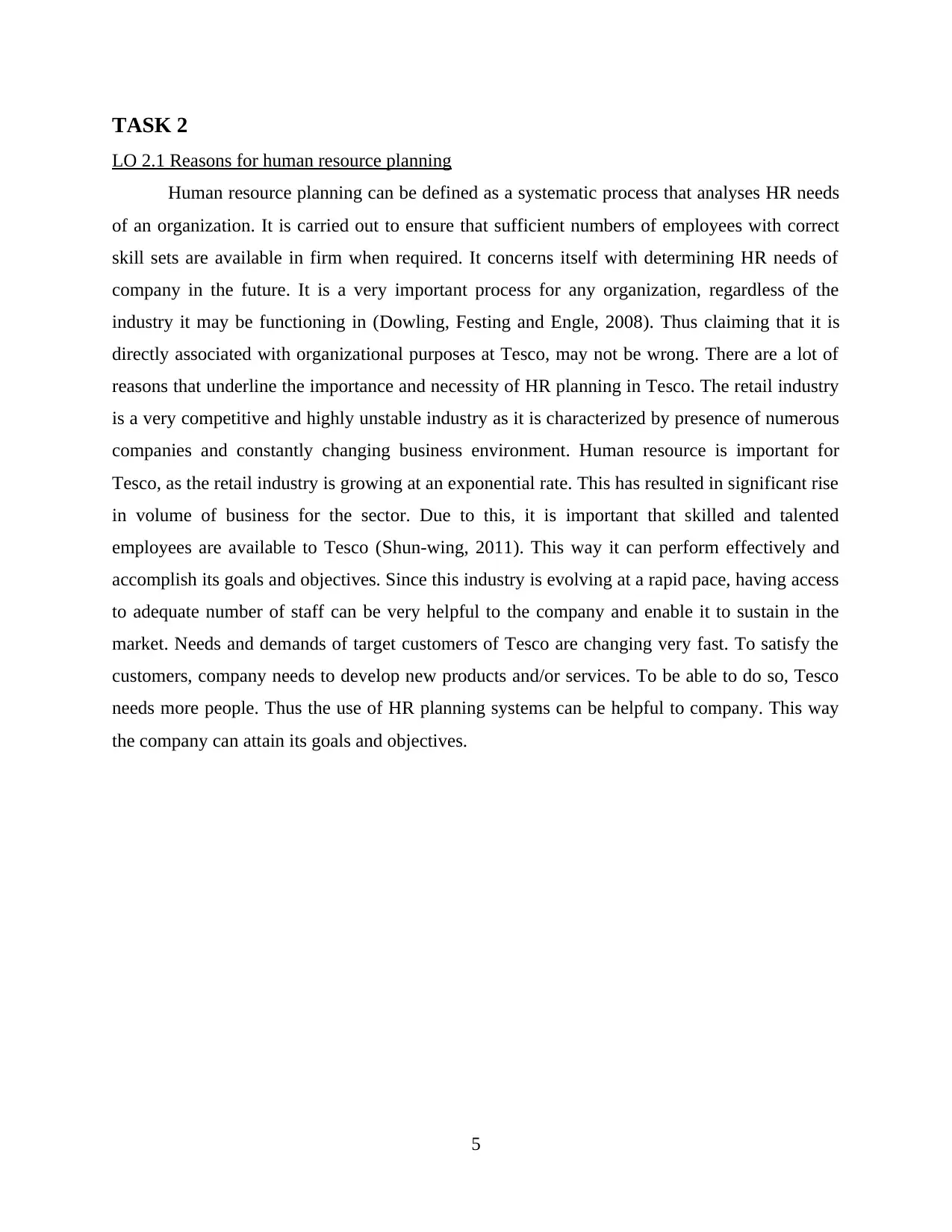
TASK 2
LO 2.1 Reasons for human resource planning
Human resource planning can be defined as a systematic process that analyses HR needs
of an organization. It is carried out to ensure that sufficient numbers of employees with correct
skill sets are available in firm when required. It concerns itself with determining HR needs of
company in the future. It is a very important process for any organization, regardless of the
industry it may be functioning in (Dowling, Festing and Engle, 2008). Thus claiming that it is
directly associated with organizational purposes at Tesco, may not be wrong. There are a lot of
reasons that underline the importance and necessity of HR planning in Tesco. The retail industry
is a very competitive and highly unstable industry as it is characterized by presence of numerous
companies and constantly changing business environment. Human resource is important for
Tesco, as the retail industry is growing at an exponential rate. This has resulted in significant rise
in volume of business for the sector. Due to this, it is important that skilled and talented
employees are available to Tesco (Shun-wing, 2011). This way it can perform effectively and
accomplish its goals and objectives. Since this industry is evolving at a rapid pace, having access
to adequate number of staff can be very helpful to the company and enable it to sustain in the
market. Needs and demands of target customers of Tesco are changing very fast. To satisfy the
customers, company needs to develop new products and/or services. To be able to do so, Tesco
needs more people. Thus the use of HR planning systems can be helpful to company. This way
the company can attain its goals and objectives.
5
LO 2.1 Reasons for human resource planning
Human resource planning can be defined as a systematic process that analyses HR needs
of an organization. It is carried out to ensure that sufficient numbers of employees with correct
skill sets are available in firm when required. It concerns itself with determining HR needs of
company in the future. It is a very important process for any organization, regardless of the
industry it may be functioning in (Dowling, Festing and Engle, 2008). Thus claiming that it is
directly associated with organizational purposes at Tesco, may not be wrong. There are a lot of
reasons that underline the importance and necessity of HR planning in Tesco. The retail industry
is a very competitive and highly unstable industry as it is characterized by presence of numerous
companies and constantly changing business environment. Human resource is important for
Tesco, as the retail industry is growing at an exponential rate. This has resulted in significant rise
in volume of business for the sector. Due to this, it is important that skilled and talented
employees are available to Tesco (Shun-wing, 2011). This way it can perform effectively and
accomplish its goals and objectives. Since this industry is evolving at a rapid pace, having access
to adequate number of staff can be very helpful to the company and enable it to sustain in the
market. Needs and demands of target customers of Tesco are changing very fast. To satisfy the
customers, company needs to develop new products and/or services. To be able to do so, Tesco
needs more people. Thus the use of HR planning systems can be helpful to company. This way
the company can attain its goals and objectives.
5
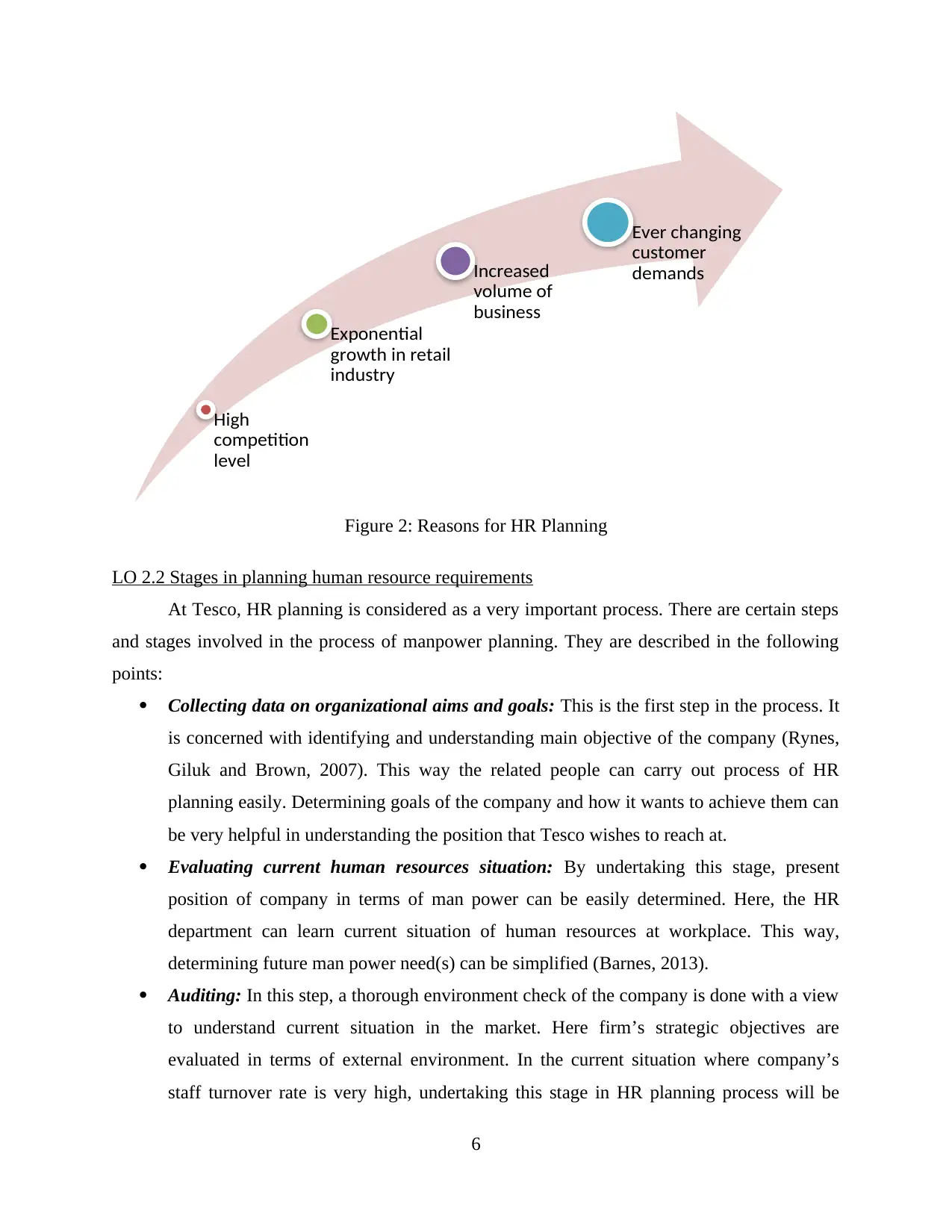
Figure 2: Reasons for HR Planning
LO 2.2 Stages in planning human resource requirements
At Tesco, HR planning is considered as a very important process. There are certain steps
and stages involved in the process of manpower planning. They are described in the following
points:
Collecting data on organizational aims and goals: This is the first step in the process. It
is concerned with identifying and understanding main objective of the company (Rynes,
Giluk and Brown, 2007). This way the related people can carry out process of HR
planning easily. Determining goals of the company and how it wants to achieve them can
be very helpful in understanding the position that Tesco wishes to reach at.
Evaluating current human resources situation: By undertaking this stage, present
position of company in terms of man power can be easily determined. Here, the HR
department can learn current situation of human resources at workplace. This way,
determining future man power need(s) can be simplified (Barnes, 2013).
Auditing: In this step, a thorough environment check of the company is done with a view
to understand current situation in the market. Here firm’s strategic objectives are
evaluated in terms of external environment. In the current situation where company’s
staff turnover rate is very high, undertaking this stage in HR planning process will be
6
High
competition
level
Exponential
growth in retail
industry
Increased
volume of
business
Ever changing
customer
demands
LO 2.2 Stages in planning human resource requirements
At Tesco, HR planning is considered as a very important process. There are certain steps
and stages involved in the process of manpower planning. They are described in the following
points:
Collecting data on organizational aims and goals: This is the first step in the process. It
is concerned with identifying and understanding main objective of the company (Rynes,
Giluk and Brown, 2007). This way the related people can carry out process of HR
planning easily. Determining goals of the company and how it wants to achieve them can
be very helpful in understanding the position that Tesco wishes to reach at.
Evaluating current human resources situation: By undertaking this stage, present
position of company in terms of man power can be easily determined. Here, the HR
department can learn current situation of human resources at workplace. This way,
determining future man power need(s) can be simplified (Barnes, 2013).
Auditing: In this step, a thorough environment check of the company is done with a view
to understand current situation in the market. Here firm’s strategic objectives are
evaluated in terms of external environment. In the current situation where company’s
staff turnover rate is very high, undertaking this stage in HR planning process will be
6
High
competition
level
Exponential
growth in retail
industry
Increased
volume of
business
Ever changing
customer
demands
⊘ This is a preview!⊘
Do you want full access?
Subscribe today to unlock all pages.

Trusted by 1+ million students worldwide
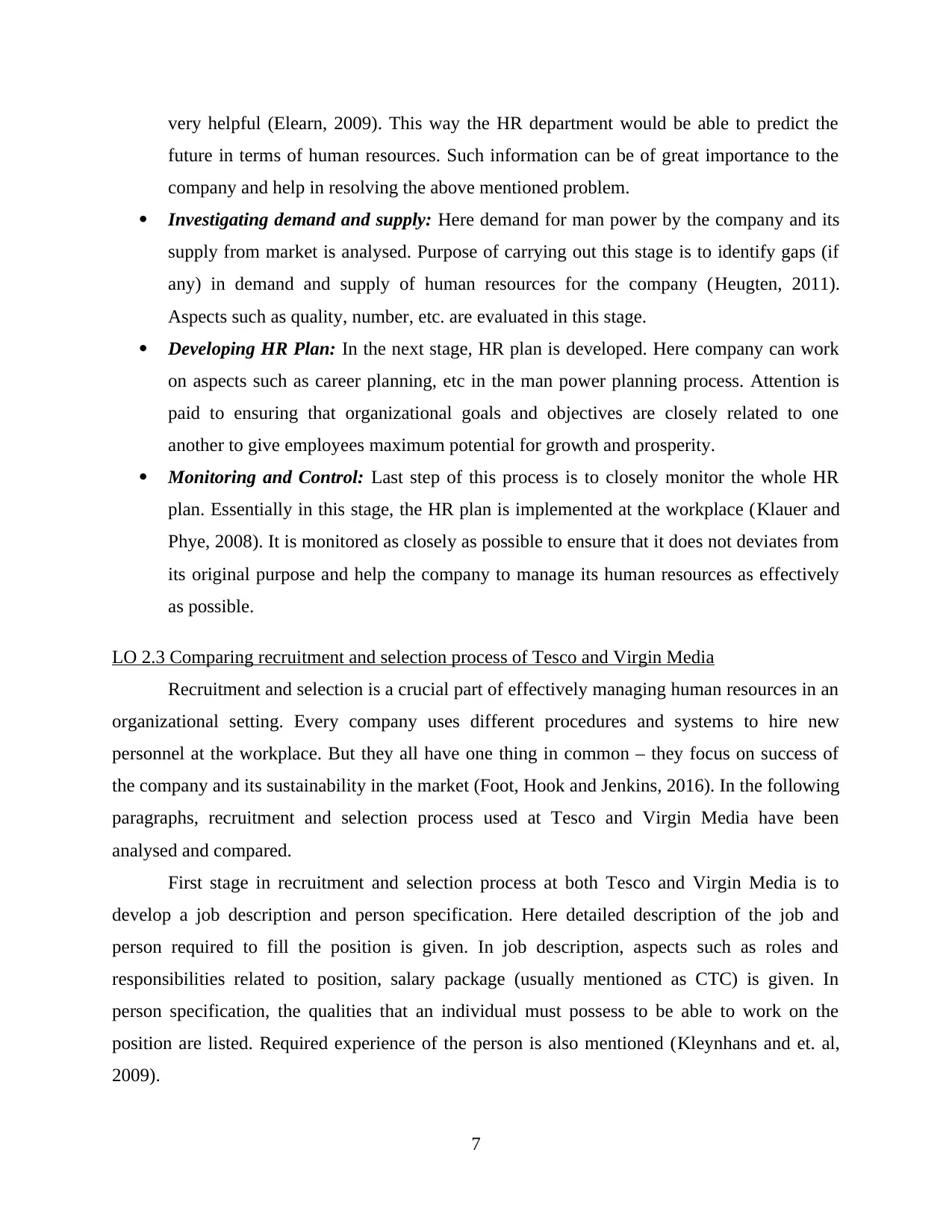
very helpful (Elearn, 2009). This way the HR department would be able to predict the
future in terms of human resources. Such information can be of great importance to the
company and help in resolving the above mentioned problem.
Investigating demand and supply: Here demand for man power by the company and its
supply from market is analysed. Purpose of carrying out this stage is to identify gaps (if
any) in demand and supply of human resources for the company (Heugten, 2011).
Aspects such as quality, number, etc. are evaluated in this stage.
Developing HR Plan: In the next stage, HR plan is developed. Here company can work
on aspects such as career planning, etc in the man power planning process. Attention is
paid to ensuring that organizational goals and objectives are closely related to one
another to give employees maximum potential for growth and prosperity.
Monitoring and Control: Last step of this process is to closely monitor the whole HR
plan. Essentially in this stage, the HR plan is implemented at the workplace (Klauer and
Phye, 2008). It is monitored as closely as possible to ensure that it does not deviates from
its original purpose and help the company to manage its human resources as effectively
as possible.
LO 2.3 Comparing recruitment and selection process of Tesco and Virgin Media
Recruitment and selection is a crucial part of effectively managing human resources in an
organizational setting. Every company uses different procedures and systems to hire new
personnel at the workplace. But they all have one thing in common – they focus on success of
the company and its sustainability in the market (Foot, Hook and Jenkins, 2016). In the following
paragraphs, recruitment and selection process used at Tesco and Virgin Media have been
analysed and compared.
First stage in recruitment and selection process at both Tesco and Virgin Media is to
develop a job description and person specification. Here detailed description of the job and
person required to fill the position is given. In job description, aspects such as roles and
responsibilities related to position, salary package (usually mentioned as CTC) is given. In
person specification, the qualities that an individual must possess to be able to work on the
position are listed. Required experience of the person is also mentioned (Kleynhans and et. al,
2009).
7
future in terms of human resources. Such information can be of great importance to the
company and help in resolving the above mentioned problem.
Investigating demand and supply: Here demand for man power by the company and its
supply from market is analysed. Purpose of carrying out this stage is to identify gaps (if
any) in demand and supply of human resources for the company (Heugten, 2011).
Aspects such as quality, number, etc. are evaluated in this stage.
Developing HR Plan: In the next stage, HR plan is developed. Here company can work
on aspects such as career planning, etc in the man power planning process. Attention is
paid to ensuring that organizational goals and objectives are closely related to one
another to give employees maximum potential for growth and prosperity.
Monitoring and Control: Last step of this process is to closely monitor the whole HR
plan. Essentially in this stage, the HR plan is implemented at the workplace (Klauer and
Phye, 2008). It is monitored as closely as possible to ensure that it does not deviates from
its original purpose and help the company to manage its human resources as effectively
as possible.
LO 2.3 Comparing recruitment and selection process of Tesco and Virgin Media
Recruitment and selection is a crucial part of effectively managing human resources in an
organizational setting. Every company uses different procedures and systems to hire new
personnel at the workplace. But they all have one thing in common – they focus on success of
the company and its sustainability in the market (Foot, Hook and Jenkins, 2016). In the following
paragraphs, recruitment and selection process used at Tesco and Virgin Media have been
analysed and compared.
First stage in recruitment and selection process at both Tesco and Virgin Media is to
develop a job description and person specification. Here detailed description of the job and
person required to fill the position is given. In job description, aspects such as roles and
responsibilities related to position, salary package (usually mentioned as CTC) is given. In
person specification, the qualities that an individual must possess to be able to work on the
position are listed. Required experience of the person is also mentioned (Kleynhans and et. al,
2009).
7
Paraphrase This Document
Need a fresh take? Get an instant paraphrase of this document with our AI Paraphraser

In Virgin Media, either an online assessment test is conducted or CV of the applicant is
reviewed. Main objective of this stage is to assess personality of the individual and decide
whether or not he/she is eligible for the profile. On the other hand, in Tesco, no such preliminary
assessment is made; rather the applicant can directly give the interview (Liao, 2009). Essentially,
recruitment and selection process at Tesco comprises two stages – first round telephonic
interview with HR and the final interview with head of department for which application has
been received. In contrast to it, at Virgin Media, if the applicant clears the first round, then a
telephonic interview is conducted. Once short listed from this stage, they are invited for a
personal interview and after clearing this stage, job is offered to them.
LO 2.4 Evaluating effectiveness of recruitment and selection process at Tesco against Virgin
Media’s
The said recruitment and selection process used by Tesco has proved to be fairly
effective. It has not given the company results that it would have asked for. This can be
supported through fact that though Tesco has attained significant success in the retail market, it is
one of the leading organizations in this space; but in recent years, its staff turnover has increased
alarmingly (Dessler, 2015). This means that there is an issue with its HRM policies. One of the
components is the recruitment and selection procedures. Therefore these processes have not
turned out to be very useful and effective for the company. On other hand, Virgin Media has
experienced significant growth over the last few years, as it has grown at an exponential rate. Its
selection process has resulted in hiring of talented and skilled staff members who have stayed
with the firm for a long time and have helped it grow. Virgin Media’s recruitment and selection
process is far more effective than that of Tesco’s (Compton and et. al, 2009).
A telephonic interview of the candidates is done, before a personal interview is
organised. Various questions are asked to them. But these questions are not related to learning
about their aim in life, or why they want to work with the company, or their skills and abilities.
Only one aptitude test is conducted in the retail firm to analyse skills of the candidates. But on
the other hand, in Virgin Media at-least two such tests are conducted. This gives the HR
managers as well as the department head(s) detailed insights about personality of the applicant
(Heugten, 2011). This way they can make effective decision as to whether or not hire the
concerned individual. This approach has made Virgin Media one of the best places to work in.
8
reviewed. Main objective of this stage is to assess personality of the individual and decide
whether or not he/she is eligible for the profile. On the other hand, in Tesco, no such preliminary
assessment is made; rather the applicant can directly give the interview (Liao, 2009). Essentially,
recruitment and selection process at Tesco comprises two stages – first round telephonic
interview with HR and the final interview with head of department for which application has
been received. In contrast to it, at Virgin Media, if the applicant clears the first round, then a
telephonic interview is conducted. Once short listed from this stage, they are invited for a
personal interview and after clearing this stage, job is offered to them.
LO 2.4 Evaluating effectiveness of recruitment and selection process at Tesco against Virgin
Media’s
The said recruitment and selection process used by Tesco has proved to be fairly
effective. It has not given the company results that it would have asked for. This can be
supported through fact that though Tesco has attained significant success in the retail market, it is
one of the leading organizations in this space; but in recent years, its staff turnover has increased
alarmingly (Dessler, 2015). This means that there is an issue with its HRM policies. One of the
components is the recruitment and selection procedures. Therefore these processes have not
turned out to be very useful and effective for the company. On other hand, Virgin Media has
experienced significant growth over the last few years, as it has grown at an exponential rate. Its
selection process has resulted in hiring of talented and skilled staff members who have stayed
with the firm for a long time and have helped it grow. Virgin Media’s recruitment and selection
process is far more effective than that of Tesco’s (Compton and et. al, 2009).
A telephonic interview of the candidates is done, before a personal interview is
organised. Various questions are asked to them. But these questions are not related to learning
about their aim in life, or why they want to work with the company, or their skills and abilities.
Only one aptitude test is conducted in the retail firm to analyse skills of the candidates. But on
the other hand, in Virgin Media at-least two such tests are conducted. This gives the HR
managers as well as the department head(s) detailed insights about personality of the applicant
(Heugten, 2011). This way they can make effective decision as to whether or not hire the
concerned individual. This approach has made Virgin Media one of the best places to work in.
8
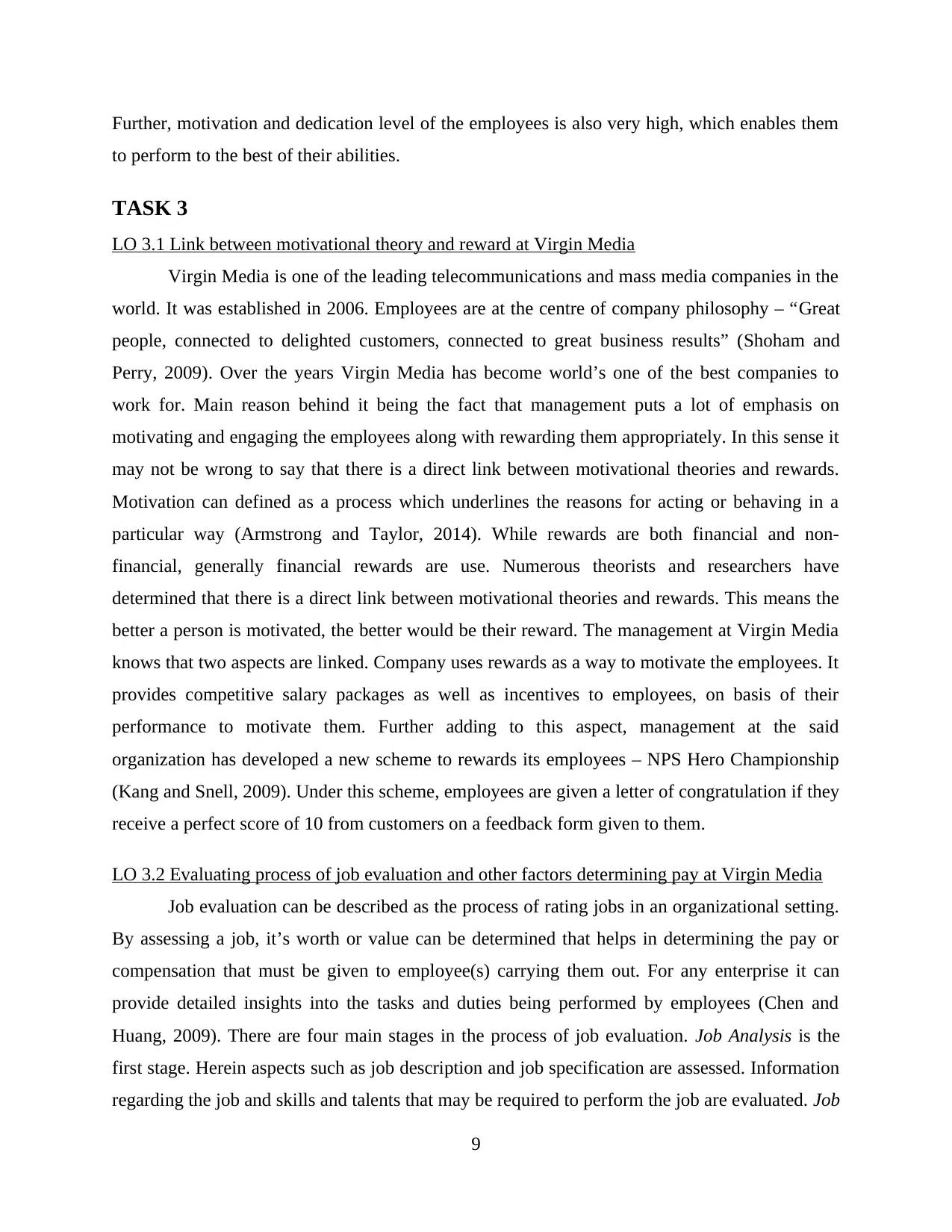
Further, motivation and dedication level of the employees is also very high, which enables them
to perform to the best of their abilities.
TASK 3
LO 3.1 Link between motivational theory and reward at Virgin Media
Virgin Media is one of the leading telecommunications and mass media companies in the
world. It was established in 2006. Employees are at the centre of company philosophy – “Great
people, connected to delighted customers, connected to great business results” (Shoham and
Perry, 2009). Over the years Virgin Media has become world’s one of the best companies to
work for. Main reason behind it being the fact that management puts a lot of emphasis on
motivating and engaging the employees along with rewarding them appropriately. In this sense it
may not be wrong to say that there is a direct link between motivational theories and rewards.
Motivation can defined as a process which underlines the reasons for acting or behaving in a
particular way (Armstrong and Taylor, 2014). While rewards are both financial and non-
financial, generally financial rewards are use. Numerous theorists and researchers have
determined that there is a direct link between motivational theories and rewards. This means the
better a person is motivated, the better would be their reward. The management at Virgin Media
knows that two aspects are linked. Company uses rewards as a way to motivate the employees. It
provides competitive salary packages as well as incentives to employees, on basis of their
performance to motivate them. Further adding to this aspect, management at the said
organization has developed a new scheme to rewards its employees – NPS Hero Championship
(Kang and Snell, 2009). Under this scheme, employees are given a letter of congratulation if they
receive a perfect score of 10 from customers on a feedback form given to them.
LO 3.2 Evaluating process of job evaluation and other factors determining pay at Virgin Media
Job evaluation can be described as the process of rating jobs in an organizational setting.
By assessing a job, it’s worth or value can be determined that helps in determining the pay or
compensation that must be given to employee(s) carrying them out. For any enterprise it can
provide detailed insights into the tasks and duties being performed by employees (Chen and
Huang, 2009). There are four main stages in the process of job evaluation. Job Analysis is the
first stage. Herein aspects such as job description and job specification are assessed. Information
regarding the job and skills and talents that may be required to perform the job are evaluated. Job
9
to perform to the best of their abilities.
TASK 3
LO 3.1 Link between motivational theory and reward at Virgin Media
Virgin Media is one of the leading telecommunications and mass media companies in the
world. It was established in 2006. Employees are at the centre of company philosophy – “Great
people, connected to delighted customers, connected to great business results” (Shoham and
Perry, 2009). Over the years Virgin Media has become world’s one of the best companies to
work for. Main reason behind it being the fact that management puts a lot of emphasis on
motivating and engaging the employees along with rewarding them appropriately. In this sense it
may not be wrong to say that there is a direct link between motivational theories and rewards.
Motivation can defined as a process which underlines the reasons for acting or behaving in a
particular way (Armstrong and Taylor, 2014). While rewards are both financial and non-
financial, generally financial rewards are use. Numerous theorists and researchers have
determined that there is a direct link between motivational theories and rewards. This means the
better a person is motivated, the better would be their reward. The management at Virgin Media
knows that two aspects are linked. Company uses rewards as a way to motivate the employees. It
provides competitive salary packages as well as incentives to employees, on basis of their
performance to motivate them. Further adding to this aspect, management at the said
organization has developed a new scheme to rewards its employees – NPS Hero Championship
(Kang and Snell, 2009). Under this scheme, employees are given a letter of congratulation if they
receive a perfect score of 10 from customers on a feedback form given to them.
LO 3.2 Evaluating process of job evaluation and other factors determining pay at Virgin Media
Job evaluation can be described as the process of rating jobs in an organizational setting.
By assessing a job, it’s worth or value can be determined that helps in determining the pay or
compensation that must be given to employee(s) carrying them out. For any enterprise it can
provide detailed insights into the tasks and duties being performed by employees (Chen and
Huang, 2009). There are four main stages in the process of job evaluation. Job Analysis is the
first stage. Herein aspects such as job description and job specification are assessed. Information
regarding the job and skills and talents that may be required to perform the job are evaluated. Job
9
⊘ This is a preview!⊘
Do you want full access?
Subscribe today to unlock all pages.

Trusted by 1+ million students worldwide
1 out of 18
Related Documents
Your All-in-One AI-Powered Toolkit for Academic Success.
+13062052269
info@desklib.com
Available 24*7 on WhatsApp / Email
![[object Object]](/_next/static/media/star-bottom.7253800d.svg)
Unlock your academic potential
Copyright © 2020–2025 A2Z Services. All Rights Reserved. Developed and managed by ZUCOL.





